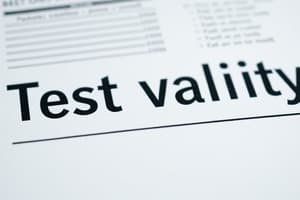Podcast
Questions and Answers
Which of the following statistical analyses is used to determine the internal consistency of a test comprising items with responses on a Likert scale?
Which of the following statistical analyses is used to determine the internal consistency of a test comprising items with responses on a Likert scale?
- Pearson's r correlation
- Kuder-Richardson formula
- Cronbach's alpha (correct)
- Spearman-Brown coefficient
In the context of test reliability, what does a significant and positive correlation coefficient in a test-retest reliability assessment indicate?
In the context of test reliability, what does a significant and positive correlation coefficient in a test-retest reliability assessment indicate?
- The test has temporal stability over time. (correct)
- The two versions of the test are dissimilar.
- The test lacks internal consistency.
- The test measures different constructs at different times.
A researcher aims to establish the reliability of a new aptitude test. To do this, they administer two different but equivalent versions of the test to the same group of participants and then correlate the scores. Which method of assessing reliability is being used?
A researcher aims to establish the reliability of a new aptitude test. To do this, they administer two different but equivalent versions of the test to the same group of participants and then correlate the scores. Which method of assessing reliability is being used?
- Split-half reliability
- Inter-rater reliability
- Parallel forms reliability (correct)
- Test-retest reliability
What does a high value of Kendall's tau coefficient of concordance indicate in the context of inter-rater reliability?
What does a high value of Kendall's tau coefficient of concordance indicate in the context of inter-rater reliability?
If a teacher aims to assess the consistency of a test across different administrations to the same group, which method of reliability assessment is most appropriate?
If a teacher aims to assess the consistency of a test across different administrations to the same group, which method of reliability assessment is most appropriate?
When is the split-half method most applicable for estimating test reliability?
When is the split-half method most applicable for estimating test reliability?
In the context of establishing test validity, what is the primary goal of content validity?
In the context of establishing test validity, what is the primary goal of content validity?
What type of validity is being assessed when a researcher examines whether a test accurately predicts students' future grades?
What type of validity is being assessed when a researcher examines whether a test accurately predicts students' future grades?
What is the primary focus of face validity in test construction?
What is the primary focus of face validity in test construction?
Which type of validity is demonstrated when two or more measures, designed to assess the same characteristic, are administered to the same examinees, and their scores are correlated?
Which type of validity is demonstrated when two or more measures, designed to assess the same characteristic, are administered to the same examinees, and their scores are correlated?
In a test designed to measure multiple constructs, what statistical procedure is typically used to determine if the items written truly align with their intended construct?
In a test designed to measure multiple constructs, what statistical procedure is typically used to determine if the items written truly align with their intended construct?
What is the purpose of establishing construct validity for a psychological test?
What is the purpose of establishing construct validity for a psychological test?
Which statistical method is most suitable for determining the relationship between two sets of scores when assessing test-retest reliability?
Which statistical method is most suitable for determining the relationship between two sets of scores when assessing test-retest reliability?
In the context of test item difficulty, what does an item difficulty index of 0.80 generally indicate?
In the context of test item difficulty, what does an item difficulty index of 0.80 generally indicate?
When conducting an item analysis, what is the primary purpose of calculating the discrimination index?
When conducting an item analysis, what is the primary purpose of calculating the discrimination index?
What range defines items which are considered of average difficulty?
What range defines items which are considered of average difficulty?
What formula is used to obtain item difficulty?
What formula is used to obtain item difficulty?
What is the definition of negative correlation?
What is the definition of negative correlation?
If the value of the correlation coefficient is 0.90, what type of indication is that?
If the value of the correlation coefficient is 0.90, what type of indication is that?
What level should Cronbach's alpha value be to ensure the internal consistency of the items?
What level should Cronbach's alpha value be to ensure the internal consistency of the items?
Flashcards
What is test reliability?
What is test reliability?
Consistency of the responses to measure under three conditions: retested on the same person, retested on the same measure, and similarity of responses across items measuring the same characteristic.
Number of Items in a Test
Number of Items in a Test
The more items a test has, the higher the likelihood of reliability due to a larger pool of items.
Individual Differences
Individual Differences
Characteristics of participants such as fatigue, concentration, innate ability, perseverance, and motivation can affect their test performance.
External Environment
External Environment
Signup and view all the flashcards
Test-Retest Reliability
Test-Retest Reliability
Signup and view all the flashcards
Parallel Forms Reliability
Parallel Forms Reliability
Signup and view all the flashcards
Split-Half Reliability
Split-Half Reliability
Signup and view all the flashcards
Internal Consistency
Internal Consistency
Signup and view all the flashcards
Inter-Rater Reliability
Inter-Rater Reliability
Signup and view all the flashcards
Linear Regression
Linear Regression
Signup and view all the flashcards
Pearson r Correlation
Pearson r Correlation
Signup and view all the flashcards
What is validity?
What is validity?
Signup and view all the flashcards
Content Validity
Content Validity
Signup and view all the flashcards
Face Validity
Face Validity
Signup and view all the flashcards
Predictive Validity
Predictive Validity
Signup and view all the flashcards
Construct Validity
Construct Validity
Signup and view all the flashcards
Concurrent Validity
Concurrent Validity
Signup and view all the flashcards
Convergent validity
Convergent validity
Signup and view all the flashcards
Divergent validity
Divergent validity
Signup and view all the flashcards
Item difficulty
Item difficulty
Signup and view all the flashcards
Study Notes
- Use procedures and statistical analysis to establish test validity and reliability.
- Decide whether a test is valid or reliable.
- Decide which test items are easy and difficult.
Significant Culminating Performance Task
- Demonstrate knowledge and skills in determining whether tests and their items are valid and reliable.
Specific Performance Tasks and Success Indicators
- Use appropriate procedure in determining test validity and reliability.
- Provide detailed steps, decision, and rationale in using appropriate validity and reliability measures.
- Show the procedure on how to establish test validity and reliability.
- Provide detailed procedure from the preparation of the instrument, procedure in pretesting, and analysis in determining the test's validity and reliability.
- Provide accurate results in the analysis of item difficulty and reliability.
- Make appropriate computation, use of software, reporting of results, and interpretation of the results for the tests of validity and reliability.
- Should have prepared a test following the proper procedure with clear learning targets (objectives), table of specifications, and pretest data per item.
- Assessment becomes valid when test items represent a good set of objectives in the table of specifications.
Test Reliability
- In order to establish the validity and reliability of an assessment tool, you need to know the different ways of establishing test validity and reliability.
- Reliability is the consistency of responses to measure under three conditions:
- When retested on the same person.
- When retested on the same measure.
- Similarity of responses across items measuring the same characteristic.
- Consistent response is expected when the test is given to the same participants.
- Reliability is attained if the responses to the same test are consistent with the same test (or its equivalent) or another test that measures the same characteristic when administered at a different time.
- There is reliability when a person responds in the same way or consistently across items that measure the same characteristic.
Factors Affecting Reliability
- Number of Items in a Test: More items increase the likelihood of high reliability due to a larger pool of items.
- Individual Differences of Participants: Factors like fatigue, concentration, innate ability, can affect test performance and the consistency of answers.
- External Environment: Room temperature, noise level, depth of instruction, exposure to materials can affect examinee responses in a test.
Ways to Establish Test Reliability
- There are different ways in determining the reliability of a test.
- The specific kind of reliability depends on the variable, type, and the number of versions of the test.
Test-Retest Reliability
- Administer the same test to the same group of examinees at two different times.
- Maintain a time interval of no more than 6 months between administrations, especially for tests measuring stable characteristics.
- A short post test with at least a 30 minute interval can also be given.
- Responses should be similar across both administrations.
- Applicable for tests measuring stable variables (aptitude, psychomotor skills).
- Correlate test scores from the first and second administrations.
- A significant and positive correlation indicates temporal stability over time.
- Correlation refers to a statistical procedure where a linear relationship is expected for two variables.
- Pearson Product Moment Correlation can be used because test data are usually in an interval scale.
Parallel Forms Reliability
- Use two versions of a test measuring the same skills.
- Administer both forms to the same group of participants.
- Responses on both forms should be similar.
- Applicable when there are two versions of the test, especially for repeated administrations to different groups.
- Correlate test results for the first and second forms.
- A significant and positive correlation coefficient is expected, indicating the versions are consistent.
- Pearson r is usually used for this analysis.
Split-Half Reliability
- Administer a test to a group of examinees.
- Split the test into two halves (usually odd vs. even items).
- Correlate the scores from the item halves.
- Each examinee will have two scores coming from the same test.
- Split-half is applicable if the test has a large number of items.
- Correlate the two sets of scores using Pearson r.
- Apply the Spearman-Brown Coefficient.
- The correlation coefficient obtained should be significant and positive to mean that the test has internal consistency reliability.
Internal Consistency Reliability Using Kuder-Richardson and Cronbach's Alpha Method
- Determine if scores for each item are consistently answered by examinees.
- Administer the test and record scores for each item.
- Works well with assessment tools having a large number of items and scales/inventories.
- Use Cronbach's alpha or Kuder-Richardson to determine internal consistency of the items.
- A Cronbach's alpha of 0.60 or above indicates internal consistency.
Inter-Rater Reliability
- Determine the consistency of ratings by multiple raters using rating scales or rubrics.
- Focuses on the similarity or consistency of ratings provided by multiple raters using the same assessment tool.
- Applicable when the assessment requires multiple raters.
- Use Kendall's tau coefficient of concordance to determine if ratings by multiple raters agree.
- A significant Kendall's tau value indicates that raters concur.
Statistical Analysis and Linear Regression
- Statistical analysis, particularly linear regression, is required to determine test reliability.
Linear Regression
- Linear regression is demonstrated with two variables measured, such as two sets of scores in a test taken at two different times by the same participants.
- When the two scores are plotted in a graph (with X- and Y-axis), they tend to form a straight line.
- The straight line formed for the two sets of scores can produce a linear regression.
- When a straight line is formed, we can say that there is a correlation between the two sets of scores.
- The graph that represents this correlation is called a scatterplot.
Computation of Pearson r Correlation
- Correlation coefficient is the index of the linear regression.
- Strong correlations occur when points in a scatterplot closely follow a linear line.
- Correlation coefficient is calculated as:
- r = [N(ΣXY) – (ΣX)(ΣY)] / √{[N(ΣX²) – (ΣX)²][N(ΣY²) – (ΣY)²]}
Positive and Negative Correlation
- A positive correlation coefficient means the higher the scores in X, the higher the scores in Y, and vice versa.
- A negative correlation coefficient means the higher the scores in X, the lower the scores in Y, and vice versa.
- A positive correlation indicates reliability or consistency.
Strength of Correlation
- The value of the correlation coefficient indicates the strength of the reliability of the test
- The closer the value to 1.00 or -1.00 means the stronger the correlation.
- 0.80-1.00: Very strong relationship
- 0.6-0.79: Strong relationship
- 0.40-0.59: Substantial/marked relationship
- 0.2-0.39: Weak relationship
- 0.00-0.19: Negligible relationship
Significance of the Correlation
- The correlation obtained between two variables could be due to chance.
- In order to determine if the correlation is free of certain errors, it is tested for significance.
- When a correlation is significant, it means that the probability of the two variables being related is free of certain errors.
- When the value computed is greater than the critical value, it means that the information obtained has more than 95% chance of being correlated & is significant.
Cronbach's Alpha procedure
- Another statistical analysis mentioned to determine the internal consistency of test is the Cronbach's alpha.
- The consistency of ratings can also be obtained using a coefficient of concordance.
- The Kendall's w coefficient of concordance is used to test the agreement among raters.
- In the formula, m is the numbers of raters.
Test Validity
- A measure is valid when it measures what it is supposed to measure, such as achievement or objectives.
- Measures should have items that contain factors that are highly correlated.
- If an entrance exam is valid, it should predict success in the students` grades.
Types of Validity
- Content Validity: items represent the domain being measured.
- Procedure: The items are compared with the objectives of the program. Reviewer conducts the checking.
- Face Validity: the test is well-presented, free of errors, and well-administered.
- Procedure: The test items and layout are reviewed and tried out on a small group of respondents.
- Predictive Validity: a measure should predict a future criterion.
- Procedure: A correlation coefficient is obtained where the X-variable is used as the predictor and the Y-variable as the criterion.
- Construct Validity: the components or factors of the test should contain items that are strongly correlated.
- Procedure: The Pearson r can be used to correlate the items for each factor.
- Concurrent Validity: when two or more measures are present for each examinee that measure the same characteristic.
- Procedure: The scores on the measures should be correlated.
- Convergent Validity: When the components or factors of a test are hypothesized to have a positive correlation
- Procedure: Correlation is done for the factors of the test.
- Divergent Validity: When the components or factors of a test are hypothesized to have a negative correlation
- Procedure: Correlation is done for the factors of the test.
Determining item difficulty
- Determine accuracy and discrimination
- Item is difficult: If majority of students are unable to provide the correct answer.
- Items is easy: If majority of the students are able to answer correctly.
- Item can discriminate: If the examinees who score high in the test can answer more the items correctly than examinees who got low scores.
Procedures to determine item difficulty and discrimination
- Get the total score of each student and arrange scores from highest to lowest.
- Obtain the upper and lower 27% of the group.
- Multiply 0.27 by the total number of students, and you will get a value of 2.7. The rounded whole number value is 3.0
- Get the top three students and the bottom three students based on their total scores.
- Obtain the proportion correct for each item.
- This is computed for the upper 27% group and the lower 27% group
- Divide the total number of students by the summated total per item.
- The item difficulty is obtained using the following formula: Item difficulty = (PH + PL) / 2
Ranges to interpret item difficulty
- 0.76 or higher: Easy Item
- 0.25 to 0.75: Average Item
- 0.24 or lower: Difficult Item
- The index of discrimination is obtained using the formula: Item discrimination = pH - pL
Ranges for Index discrimination
- 0.40 and above: Very good item
- 0.30-0.39: Good item
- 0.20-0.29: Reasonably Good item
- 0.10-0.19: Marginal item
- Below 0.10: Poor item
- When developing a teacher-made test, good to have items that are easy, average, and difficult with positive discrimination indices.
- If you are developing a standardized test, the rule is more stringent as it aims for average items or not so easy nor difficult items with a discrimination index of at least 0.3.
Studying That Suits You
Use AI to generate personalized quizzes and flashcards to suit your learning preferences.




